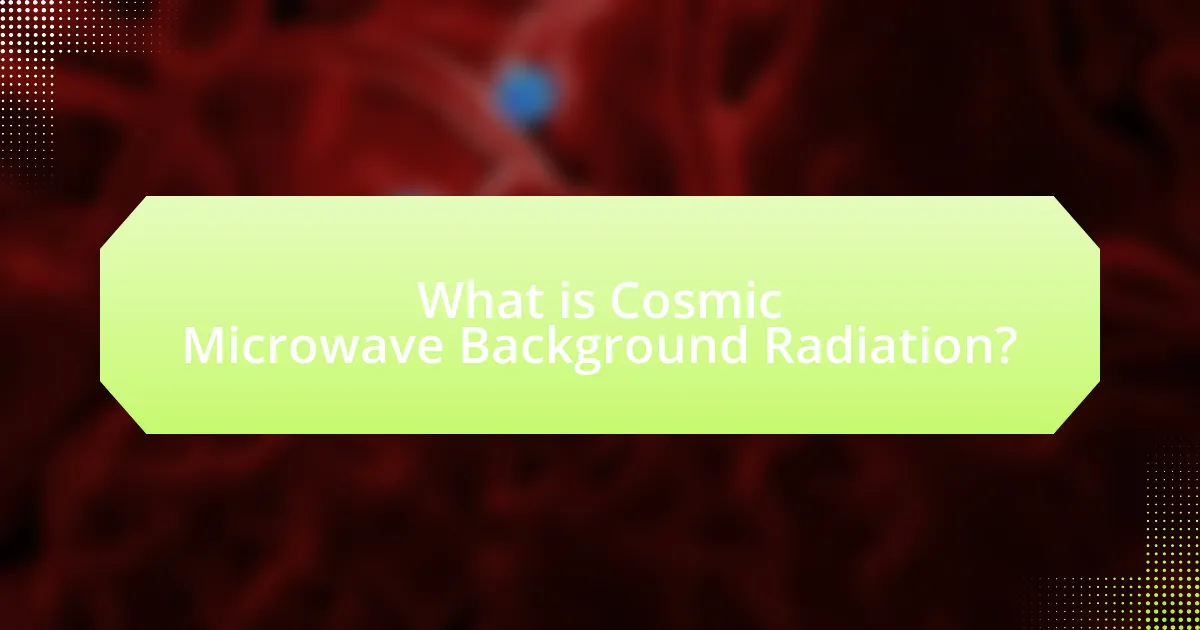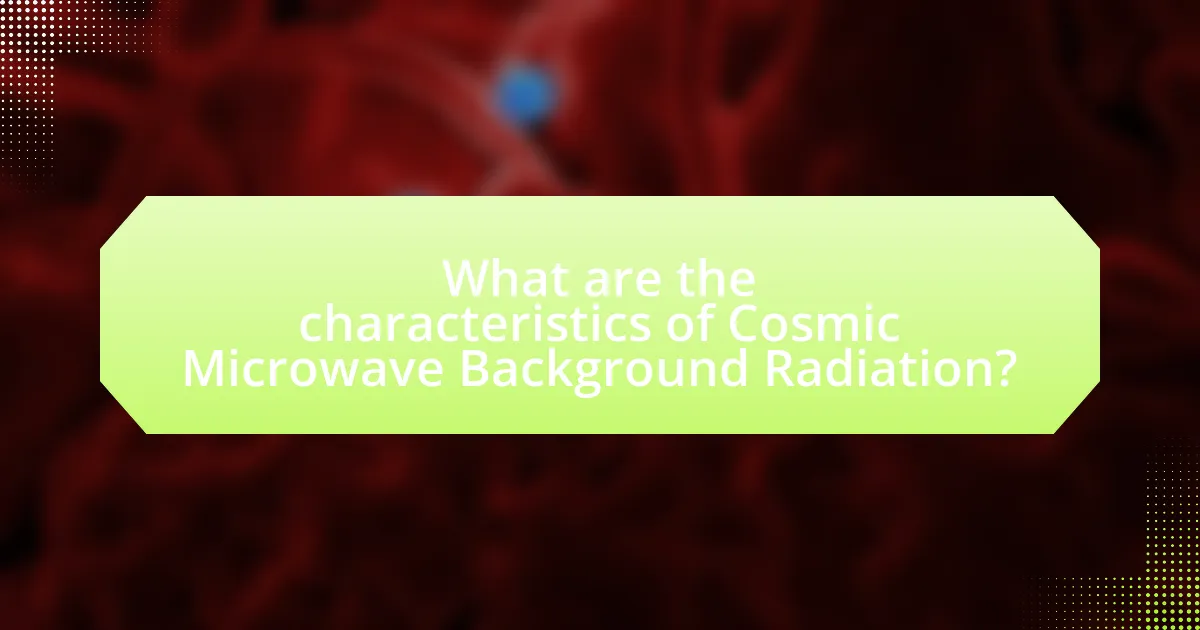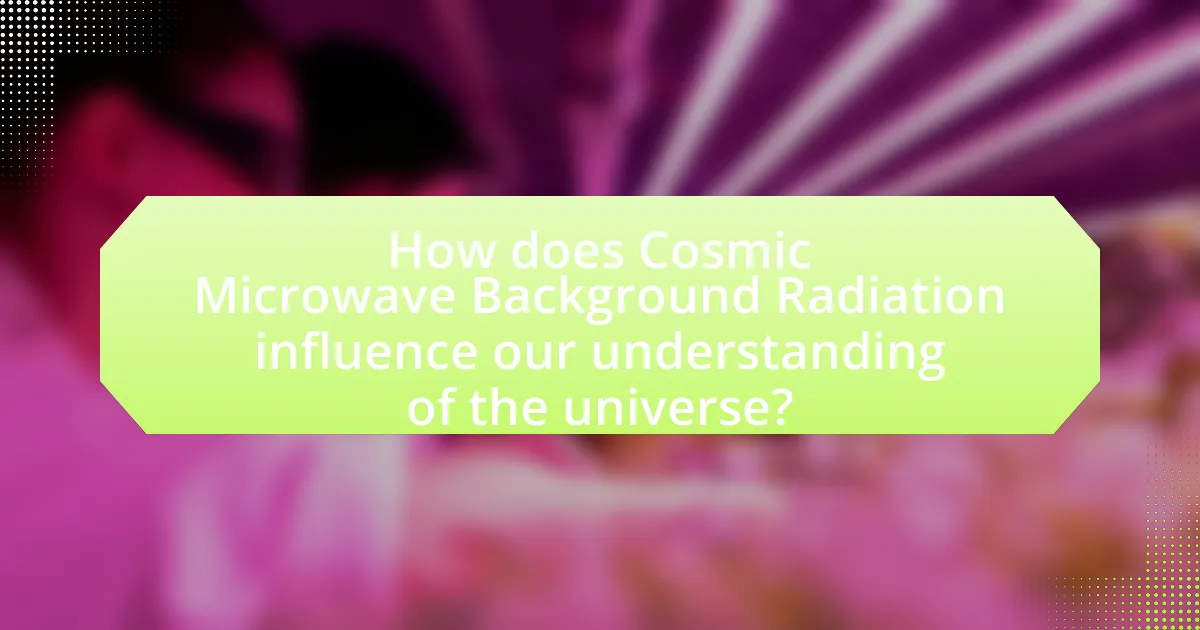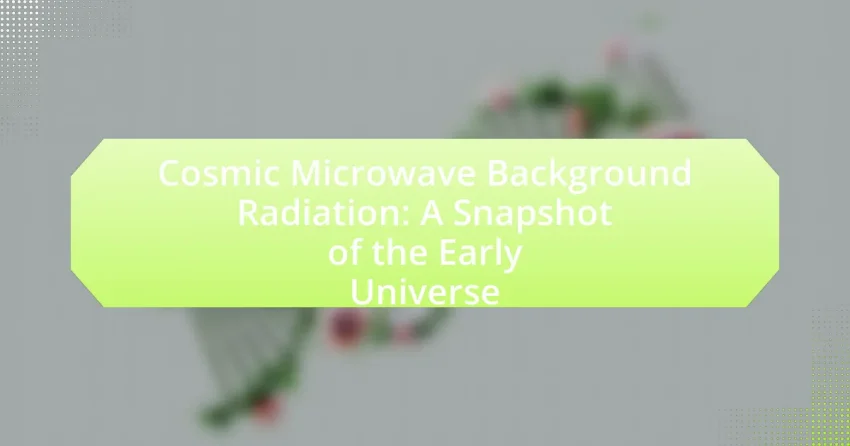Cosmic Microwave Background Radiation (CMBR) is the remnant radiation from the Big Bang, providing crucial evidence for the universe’s early conditions approximately 380,000 years after its formation. Discovered in 1965 by Arno Penzias and Robert Wilson, CMBR has a uniform temperature of about 2.7 Kelvin and exhibits slight anisotropies that reveal density variations essential for understanding the formation of galaxies and large-scale structures. This article explores the significance of CMBR in cosmology, its discovery, the experiments that confirmed its existence, and its implications for theories such as cosmic inflation and the universe’s expansion. Additionally, it discusses current research trends, future missions, and the broader impacts of CMBR studies on various scientific fields.

What is Cosmic Microwave Background Radiation?
Cosmic Microwave Background Radiation (CMB) is the afterglow of the Big Bang, consisting of low-energy microwave radiation that fills the universe. This radiation is a remnant from the early universe, specifically from about 380,000 years after the Big Bang when protons and electrons combined to form neutral hydrogen, allowing photons to travel freely. The CMB was first detected in 1965 by Arno Penzias and Robert Wilson, providing strong evidence for the Big Bang theory and offering insights into the universe’s age, composition, and large-scale structure.
How was Cosmic Microwave Background Radiation discovered?
Cosmic Microwave Background Radiation was discovered in 1965 by Arno Penzias and Robert Wilson, who detected a persistent noise in their radio antenna that was isotropic and uniform across the sky. This radiation was identified as the remnant heat from the Big Bang, providing strong evidence for the Big Bang theory. Their findings were later confirmed by the theoretical predictions made by George Gamow and others, who suggested that the universe should be filled with this radiation as a result of its hot, dense state shortly after its formation. The discovery earned Penzias and Wilson the Nobel Prize in Physics in 1978, solidifying the significance of Cosmic Microwave Background Radiation in cosmology.
What experiments led to the detection of Cosmic Microwave Background Radiation?
The detection of Cosmic Microwave Background Radiation (CMBR) was primarily achieved through the experiments conducted by Arno Penzias and Robert Wilson in 1965. Their work involved using a horn antenna at Bell Labs, which inadvertently picked up a persistent noise that was later identified as the CMBR, a remnant from the Big Bang. This discovery was corroborated by the findings of the COBE (Cosmic Background Explorer) satellite launched in 1989, which provided detailed measurements of the CMBR’s temperature and anisotropies, confirming its existence and supporting the Big Bang theory.
Who were the key scientists involved in its discovery?
The key scientists involved in the discovery of Cosmic Microwave Background Radiation (CMB) are Arno Penzias and Robert Wilson. In 1965, Penzias and Wilson detected the CMB while working at Bell Labs, leading to the confirmation of the Big Bang theory. Their findings were published in the journal “Astrophysical Journal,” where they described the uniform microwave radiation that permeates the universe, providing strong evidence for the early hot state of the cosmos. This discovery earned them the Nobel Prize in Physics in 1978, solidifying their contributions to cosmology.
Why is Cosmic Microwave Background Radiation important for cosmology?
Cosmic Microwave Background Radiation (CMBR) is crucial for cosmology because it provides a snapshot of the universe approximately 380,000 years after the Big Bang, allowing scientists to study its early conditions. The CMBR is a relic radiation that fills the universe and is nearly uniform, with slight fluctuations that indicate the density variations in the early universe. These fluctuations are essential for understanding the formation of large-scale structures, such as galaxies and galaxy clusters. The precise measurements of the CMBR, particularly from missions like the Wilkinson Microwave Anisotropy Probe (WMAP) and the Planck satellite, have confirmed key cosmological parameters, including the universe’s age, composition, and expansion rate, thereby validating the Big Bang theory and enhancing our understanding of cosmic evolution.
How does it provide evidence for the Big Bang theory?
Cosmic Microwave Background Radiation (CMB) provides evidence for the Big Bang theory by representing the afterglow of the hot, dense state of the early universe. This radiation, detected uniformly across the sky, indicates that the universe was once in a much hotter and denser condition, consistent with the predictions of the Big Bang model. The temperature of the CMB is approximately 2.7 Kelvin, which aligns with theoretical calculations of the cooling of the universe over time since the Big Bang occurred around 13.8 billion years ago. Additionally, the slight fluctuations in the CMB’s temperature reveal the density variations that led to the formation of galaxies, further supporting the Big Bang theory’s framework of cosmic evolution.
What information does it reveal about the early universe?
The Cosmic Microwave Background Radiation (CMB) reveals that the early universe was hot, dense, and nearly uniform. This radiation, which is a remnant from the Big Bang, provides evidence of the universe’s expansion and cooling over time. Measurements of the CMB’s temperature fluctuations indicate the density variations that led to the formation of galaxies and large-scale structures. Additionally, the CMB supports the theory of inflation, suggesting that the universe underwent rapid expansion shortly after the Big Bang, which is corroborated by precise observations from missions like the Wilkinson Microwave Anisotropy Probe (WMAP) and the Planck satellite.

What are the characteristics of Cosmic Microwave Background Radiation?
Cosmic Microwave Background Radiation (CMBR) is characterized by its uniformity, isotropy, and blackbody spectrum. The uniformity of CMBR indicates that it has nearly the same temperature in all directions, measured at approximately 2.7 Kelvin, which supports the Big Bang theory. Its isotropy suggests that the radiation is evenly distributed across the sky, with only slight fluctuations in temperature, known as anisotropies, which provide insights into the early universe’s density variations. The blackbody spectrum of CMBR, with a peak wavelength corresponding to microwave frequencies, confirms that it originated from a hot, dense state and has since cooled as the universe expanded. These characteristics collectively provide critical evidence for cosmological models and the evolution of the universe.
What is the temperature of Cosmic Microwave Background Radiation?
The temperature of Cosmic Microwave Background Radiation is approximately 2.7 Kelvin. This measurement indicates the residual thermal radiation from the Big Bang, which fills the universe and provides critical evidence for the Big Bang theory. The temperature has been precisely measured by instruments such as the Cosmic Background Explorer (COBE) and the Wilkinson Microwave Anisotropy Probe (WMAP), confirming its value as a key parameter in cosmology.
How does the temperature relate to the age of the universe?
The temperature of the universe is inversely related to its age, as evidenced by the cooling of the Cosmic Microwave Background (CMB) radiation. Initially, shortly after the Big Bang, the universe was extremely hot, with temperatures exceeding thousands of degrees Kelvin. As the universe expanded, it cooled, leading to the current temperature of approximately 2.7 Kelvin. This cooling trend is a direct consequence of the universe’s expansion, which has been measured and confirmed through observations of the CMB, providing a snapshot of the universe when it was about 380,000 years old. The relationship between temperature and age is fundamental in cosmology, as it helps scientists estimate the timeline of the universe’s evolution.
What variations exist in the temperature across the sky?
Variations in temperature across the sky are primarily observed in the Cosmic Microwave Background (CMB) radiation, which exhibits slight fluctuations in temperature. These fluctuations, measured in microkelvins, indicate regions of varying density in the early universe, with the temperature differences typically ranging from about 2.725 K to 2.726 K. The CMB’s anisotropies, as detected by missions like the Wilkinson Microwave Anisotropy Probe (WMAP) and the Planck satellite, reveal that these temperature variations correspond to the seeds of large-scale structures in the universe, providing critical insights into cosmic inflation and the distribution of matter.
What is the spectrum of Cosmic Microwave Background Radiation?
The spectrum of Cosmic Microwave Background Radiation (CMBR) is a nearly perfect blackbody spectrum with a temperature of approximately 2.7 Kelvin. This spectrum is characterized by a peak wavelength of about 1.9 millimeters, corresponding to a frequency of approximately 160.2 GHz, which is consistent with Planck’s law of blackbody radiation. The CMBR is a remnant from the early universe, specifically from the time of recombination, about 380,000 years after the Big Bang, when photons decoupled from matter. The uniformity and isotropy of the CMBR across the sky provide strong evidence for the Big Bang theory and the subsequent expansion of the universe.
How does the blackbody spectrum relate to its origin?
The blackbody spectrum is directly related to its origin as it represents the thermal radiation emitted by an idealized physical body in thermal equilibrium, which in the context of the universe, corresponds to the Cosmic Microwave Background (CMB) radiation. The CMB is a remnant from the early universe, specifically from the time of recombination approximately 380,000 years after the Big Bang, when the universe cooled enough for protons and electrons to combine into neutral hydrogen atoms, allowing photons to travel freely. This radiation has a nearly perfect blackbody spectrum with a temperature of about 2.7 Kelvin, confirming its origin as a relic of the hot, dense state of the early universe. The precise measurements of the CMB’s spectrum, as conducted by missions like the Wilkinson Microwave Anisotropy Probe (WMAP) and the Planck satellite, validate the blackbody nature of this radiation, supporting the Big Bang theory and providing insights into the universe’s expansion and composition.
What role does redshift play in its observation?
Redshift plays a crucial role in the observation of cosmic microwave background radiation by indicating the expansion of the universe. As the universe expands, light from distant objects, including the early radiation, stretches to longer wavelengths, resulting in redshift. This redshift allows astronomers to measure the distance and speed of these cosmic sources, providing insights into the universe’s age and the conditions shortly after the Big Bang. For instance, the cosmic microwave background radiation is observed at a redshift of approximately 1100, which corresponds to a time when the universe was about 380,000 years old, allowing scientists to study its early state and evolution.

How does Cosmic Microwave Background Radiation influence our understanding of the universe?
Cosmic Microwave Background Radiation (CMBR) significantly influences our understanding of the universe by providing evidence for the Big Bang theory and offering insights into the universe’s early conditions. The CMBR is the afterglow radiation from the hot, dense state of the universe approximately 380,000 years after the Big Bang, revealing information about its temperature, density fluctuations, and composition. Measurements of the CMBR, particularly from missions like the Wilkinson Microwave Anisotropy Probe (WMAP) and the Planck satellite, have allowed scientists to determine key cosmological parameters, such as the age of the universe (approximately 13.8 billion years), the rate of expansion, and the proportions of dark matter and dark energy. These findings have fundamentally shaped our current cosmological models and enhanced our understanding of the universe’s evolution and structure.
What insights does Cosmic Microwave Background Radiation provide about cosmic inflation?
Cosmic Microwave Background Radiation (CMB) provides critical insights into cosmic inflation by revealing the uniformity and slight anisotropies in the early universe. The CMB is a remnant radiation from the Big Bang, and its temperature fluctuations correspond to density variations that occurred during inflation. These fluctuations, measured by missions like the Wilkinson Microwave Anisotropy Probe (WMAP) and the Planck satellite, support the theory of inflation by demonstrating that the universe underwent rapid expansion, smoothing out initial irregularities and leading to the large-scale structure observed today. The specific patterns of these anisotropies align with predictions made by inflationary models, confirming that inflation was a significant phase in the universe’s evolution.
How does it support the theory of inflation in the early universe?
The Cosmic Microwave Background Radiation (CMB) supports the theory of inflation in the early universe by providing evidence of a uniform temperature across the sky, which aligns with predictions made by inflationary models. These models suggest that a rapid expansion of space occurred shortly after the Big Bang, smoothing out any initial irregularities. The CMB’s nearly isotropic nature, with slight fluctuations, corresponds to quantum fluctuations that were stretched to cosmic scales during inflation, as detailed in the work of Alan Guth and others. This observational data from the CMB, particularly the temperature anisotropies measured by missions like the Wilkinson Microwave Anisotropy Probe (WMAP) and the Planck satellite, confirms the inflationary scenario by showing that the universe underwent a period of exponential growth, leading to the large-scale structure we observe today.
What are the implications of its anisotropies for structure formation?
The implications of anisotropies in the Cosmic Microwave Background (CMB) radiation for structure formation are significant, as they provide the initial density fluctuations that lead to the formation of large-scale structures in the universe. These anisotropies, which are tiny temperature variations in the CMB, indicate regions of slightly higher and lower density in the early universe. According to the theory of cosmic inflation and subsequent gravitational collapse, these density fluctuations evolved over time, leading to the clumping of matter and the formation of galaxies and galaxy clusters. Observations from the Wilkinson Microwave Anisotropy Probe (WMAP) and the Planck satellite have quantified these anisotropies, revealing a power spectrum that correlates with the distribution of galaxies observed today, thus confirming their role in structure formation.
What are the current research trends related to Cosmic Microwave Background Radiation?
Current research trends related to Cosmic Microwave Background Radiation (CMBR) focus on improving measurements of its anisotropies, understanding inflationary models, and exploring the implications of CMBR on dark matter and dark energy. Researchers are utilizing advanced satellite missions like the European Space Agency’s Planck satellite and upcoming projects such as the Simons Observatory to gather high-resolution data. These studies aim to refine the parameters of the Lambda Cold Dark Matter model, which describes the universe’s evolution, and to investigate anomalies in the CMBR that could indicate new physics beyond the standard model of cosmology. For instance, the detection of B-mode polarization patterns in the CMBR could provide insights into gravitational waves from the early universe, further validating inflationary theories.
How are new technologies improving our understanding of Cosmic Microwave Background Radiation?
New technologies are enhancing our understanding of Cosmic Microwave Background Radiation (CMBR) by providing more precise measurements and advanced analytical techniques. For instance, the Planck satellite, launched by the European Space Agency, has delivered high-resolution maps of the CMBR, allowing scientists to analyze temperature fluctuations with unprecedented accuracy. These measurements have led to improved estimates of fundamental cosmological parameters, such as the Hubble constant and the density of dark matter and dark energy. Additionally, advancements in data processing algorithms and machine learning techniques enable researchers to extract more information from CMBR data, facilitating deeper insights into the early universe’s conditions and the formation of cosmic structures.
What future missions are planned to study Cosmic Microwave Background Radiation?
The future missions planned to study Cosmic Microwave Background Radiation include the NASA-led PICO (Primordial Inflation Explorer) mission and the European Space Agency’s (ESA) CORE (Cosmic Origins Explorer) mission. PICO aims to measure the polarization of the Cosmic Microwave Background with high precision to investigate the inflationary period of the universe, while CORE is designed to provide detailed maps of the Cosmic Microwave Background to enhance our understanding of cosmic structure formation. Both missions are expected to significantly advance our knowledge of the early universe and the fundamental physics governing it.
What practical applications arise from studying Cosmic Microwave Background Radiation?
Studying Cosmic Microwave Background Radiation (CMBR) has practical applications in understanding the universe’s origins, structure, and evolution. CMBR analysis provides insights into the Big Bang theory, allowing scientists to estimate the universe’s age at approximately 13.8 billion years. Additionally, CMBR data helps in mapping the distribution of dark matter and dark energy, which constitute about 95% of the universe’s total mass-energy content. This mapping is crucial for developing cosmological models and understanding the universe’s expansion. Furthermore, advancements in CMBR technology have led to improved techniques in signal processing and imaging, which have applications in various fields, including telecommunications and medical imaging.
How can understanding Cosmic Microwave Background Radiation impact other fields of science?
Understanding Cosmic Microwave Background Radiation (CMBR) significantly impacts fields such as cosmology, astrophysics, and particle physics by providing insights into the early universe’s conditions and the fundamental laws governing it. CMBR serves as a relic radiation from the Big Bang, allowing scientists to study the universe’s expansion, structure formation, and the distribution of matter. For instance, the precise measurements of CMBR fluctuations by the Planck satellite have led to improved estimates of the universe’s age, composition, and the rate of expansion, influencing theories in cosmology and refining models of dark energy. Additionally, CMBR analysis aids in understanding fundamental particle interactions and the conditions that led to the formation of elements during nucleosynthesis, thereby bridging gaps between cosmology and particle physics.
What lessons can we learn from Cosmic Microwave Background Radiation for future explorations?
Cosmic Microwave Background Radiation (CMB) teaches us that the early universe was hot and dense, providing a baseline for understanding cosmic evolution. This radiation, a remnant from the Big Bang, reveals the universe’s age, composition, and the formation of large-scale structures. By analyzing CMB data, such as that from the Planck satellite, scientists have determined the universe’s age to be approximately 13.8 billion years and its composition to be about 68% dark energy, 27% dark matter, and 5% ordinary matter. These insights guide future explorations by informing the design of experiments and telescopes aimed at studying cosmic phenomena, enhancing our understanding of fundamental physics and the universe’s fate.
